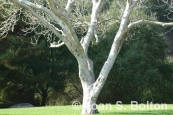
Dare to bare it all.
With your trees, that is.
Most folks plant trees for their shade, interesting leaves, beautiful flowers, or ability to block views of unsightly telephone poles and neighbors’ windows.
But there’s another reason that’s often overlooked: their profiles in winter.
There’s something intense and dramatic about certain deciduous trees on stark, wintry days. Maybe it has something to do with the bracing, dry air, or the extreme angle of the sun.
Whatever the cause, these living sculptures have much to offer after they’ve stepped out of their spring and summer coats of leaves. Some are positively stunning in silhouette, naked to the sky. Others cast tortuous shadows that grow ever longer into twilight. Still others supply distinctive, peeling bark, or unusual dried pods or fruit.
Planting one of these trees is not a quick fix for the winter blahs. For that, stick a few fresh-faced pansies in a pot. But over time, the following trees will provide invaluable structure and backbone to your winter landscape.
European White Birch (Betula pendula)

The weeping silhouette of this popular, fast-growing birch is striking. Slender branches reach skyward, gracefully curve, then plummet back toward earth. The bark peels off in large patches, revealing mottled shades of brown, black, gray and white.
In winter, dried fruit that looks somewhat like miniature pinecones picturesquely dangles from the bare branches. The only drawback is that those dainty decorations shatter in the slightest breeze and scatter everywhere.
With its tall, lacy profile, European white birch is often planted in groups of three, five or more trees. However, a single one can easily stand alone. My 25-year-old tree is more than 40 feet tall, 25 feet wide and has a trunk that’s about 2 feet across at the base.
Western Redbud (Cercis occidentalis)
After this small, round-headed tree drops its bluish-green, heart-shaped leaves, you’ll get a good look at the seed pods, which form after spring flowering. The 3 to 4-inch pods would be dead ringers for pea pods, except that they take on a purplish tan to brown cast as they ripen. The pods are appealing or unattractive, depending on your sensibility.
Western redbud is a California native. As a single-trunk tree, it grows 15 to 20 feet tall; as a multi-trunk shrub, it stays a little shorter. Either way, western redbud is long-lived, provided you plant it in a spot that has impeccable drainage and don’t inundate it with water.
Harry Lauder’s Walking Stick (Corylus avellana ‘Contorta’)
“Contorta” aptly describes the pencil-thin branches of this ornamental filbert tree, which twist in all sorts of contortions that even Henry Houdini would have found difficult to mimic. Small catkins that are just as contorted hang from the grayish-green branches in winter.
The common name refers to vaudeville performer Harry Lauder, who carried a twisted cane.
For an up-close performance, plant your walking stick in a large pot and water it regularly. A small, specimen tree, it will eventually twist and turn its way up to 10 feet tall.
Floss Silk Tree (Chorisia speciosa or Ceiba speciosa)

The base of this South American tree is reminiscent of a stout, wrinkled elephant’s foot. New bark appears relatively smooth and has a light-green tinge, then ages to gray. But more remarkable are the fat spines that stick out from the trunk and branches, looking like some sort of prehistoric armament.
Floss silk tree grows at a moderate pace to 30 to 60 feet tall and wide. It bears large, bright-pink flowers in spring, just before leafing out.
English Walnut (Juglans regia)
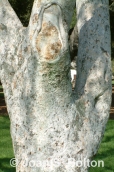
It’s messy, its fruit stains the pavement and its pollen irritates more than a few people. But English walnut tree also presents one of the most dramatic, other-worldly silhouettes in the garden in the dead of winter.
The bark is about the whitest possible. With its thick, lumbering branches and sturdy stance, the tree looms like a barren ghost on the horizon. Be sure you like the massive look, as English walnut is among the last deciduous trees to sprout new leaves in spring.
Also provide plenty of room. The trees grow fast to 60 feet tall and wide.
Crape Myrtle (Lagerstroemia indica)

This patio-size tree is perhaps best known for its brilliant cones of late-summer pink, scarlet or purple flowers. But come winter, its falling leaves expose brown and gray bark that sheds in long strips, exposing new, pink bark underneath.
Crape myrtle is grown as a large shrub or shaped into a small tree that grows about 25 feet tall. It is among the earliest trees to lose leaves in the fall, and just as late as the English walnut in leafing out in spring.
California Sycamore (Platanus racemosa)
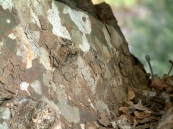
This California native tree sheds its bark in rough patches of white, gray, beige or green, revealing pale, smooth bark underneath. The bark darkens with age — upper branches are often noticeably lighter in color. Over time, deep cracks start at the base and rise up the trunk.
In winter, clusters of marble-sized, stickery balls hang from the branches. They’re useful in dried flower arrangements.
California sycamore needs space, as it grows relatively fast to 75 feet tall or more. Meanwhile, its sturdy limbs stretch 20 feet in each direction, and the base of its trunk may spread 10 feet across. Commonly found along local stream banks, its deep roots stretch out to seek moisture underground during dryer months.
Corkscrew Willow or Dragon Claw (Salix matsudana ‘Tortuosa’)
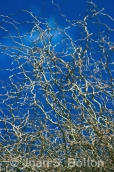
Like the bottle-opening device that lends its name, this willow curls and spirals its branches into long, slender corkscrews.
In summer, it forms a bright green dome covered in narrow leaves.
Once bare, its internal scaffolding is revealed as an arching fountain that spills thousands of soft-gray, twirling branches in checkered gray.
Corkscrew willow grows fast to 25 to 30 feet and wide.
Just like other willows, it likes regular to frequent irrigation and is beautiful when planted at the edge of a pond, its toes sipping water below while its twisty-twirly branches cascade overhead.
Chinese Elm (Ulmus parvifolia)
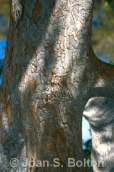
Depending on its age and location, this large tree can be shy about shedding its leaves. But with time and temperatures that are consistently in the low 20s or below, it usually cooperates.
Entirely bare or not, the new bark is a soft, rich pink, with pale gray or brown mottling.
Chinese elm grows quickly into a round-headed tree 35 to 60 feet tall and a little wider.
It is a popular street tree and when planted on both sides of a street, the graceful, outstretched limbs of a number of trees may eventually meet to form a canopy over the street.
≈
Planting a Tree
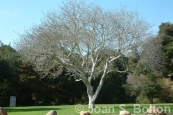
Dig the hole at least twice as wide as the nursery container and nearly as deep.
Break up any dirt clods in the backfill that you’ve unearthed.
Mix a few shovelfuls of redwood compost or other organic material into the backfill.
Consider adding Gro-Power or some other natural, slow-release fertilizer to boost the beneficial microorganisms in the soil. If your soil is heavy clay, add gypsum to improve the texture and drainage.
Roughen up the sides and bottom of the hole.
Place the tree in the hole, an inch or two higher than the existing soil to allow for settling.
Fill the hole with the backfill.
Remove any stakes that came with the tree. If necessary, re-stake the tree with two sturdy tree poles placed on opposite sides of the trunk, at least a foot out. Use stretchy green tape or flexible tree ties to secure the trunk. Leave enough slack for the tree to flex in the wind.
Shape a broad basin around the tree and fill it with water.
Once the water drains, fill the basin with mulch, keeping it an inch or two from the trunk. Then water again.
≈
Seeds of Wisdom
Install one or two low-voltage spotlights a few feet out from the trunks of your deciduous trees, then angle the lights upward to highlight the trees’ stark silhouettes at night. Be sure the beams don’t point directly into neighboring yards.
≈
Copyright, Joan S. Bolton. All rights reserved. Reproduction of text or photos in any form is prohibited without written permission.
≈
